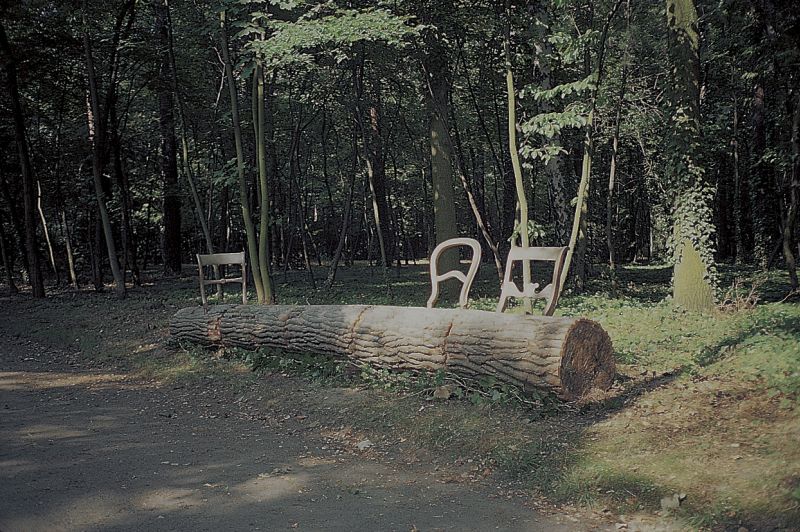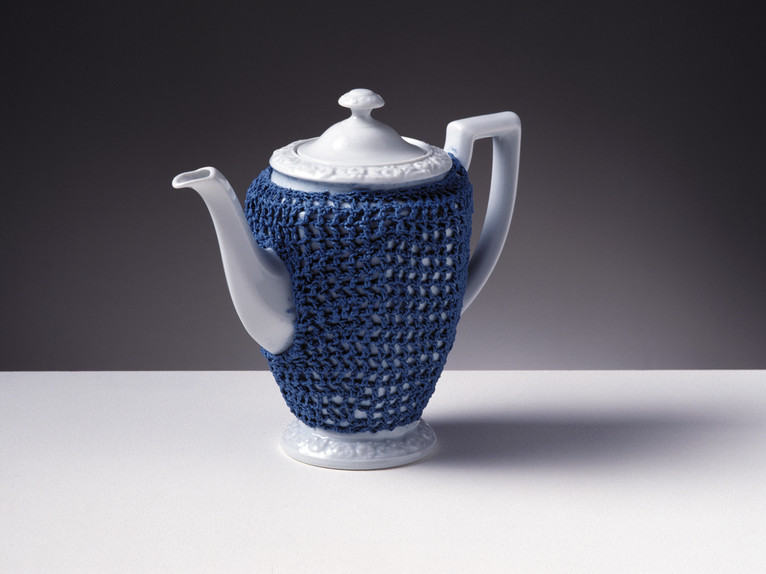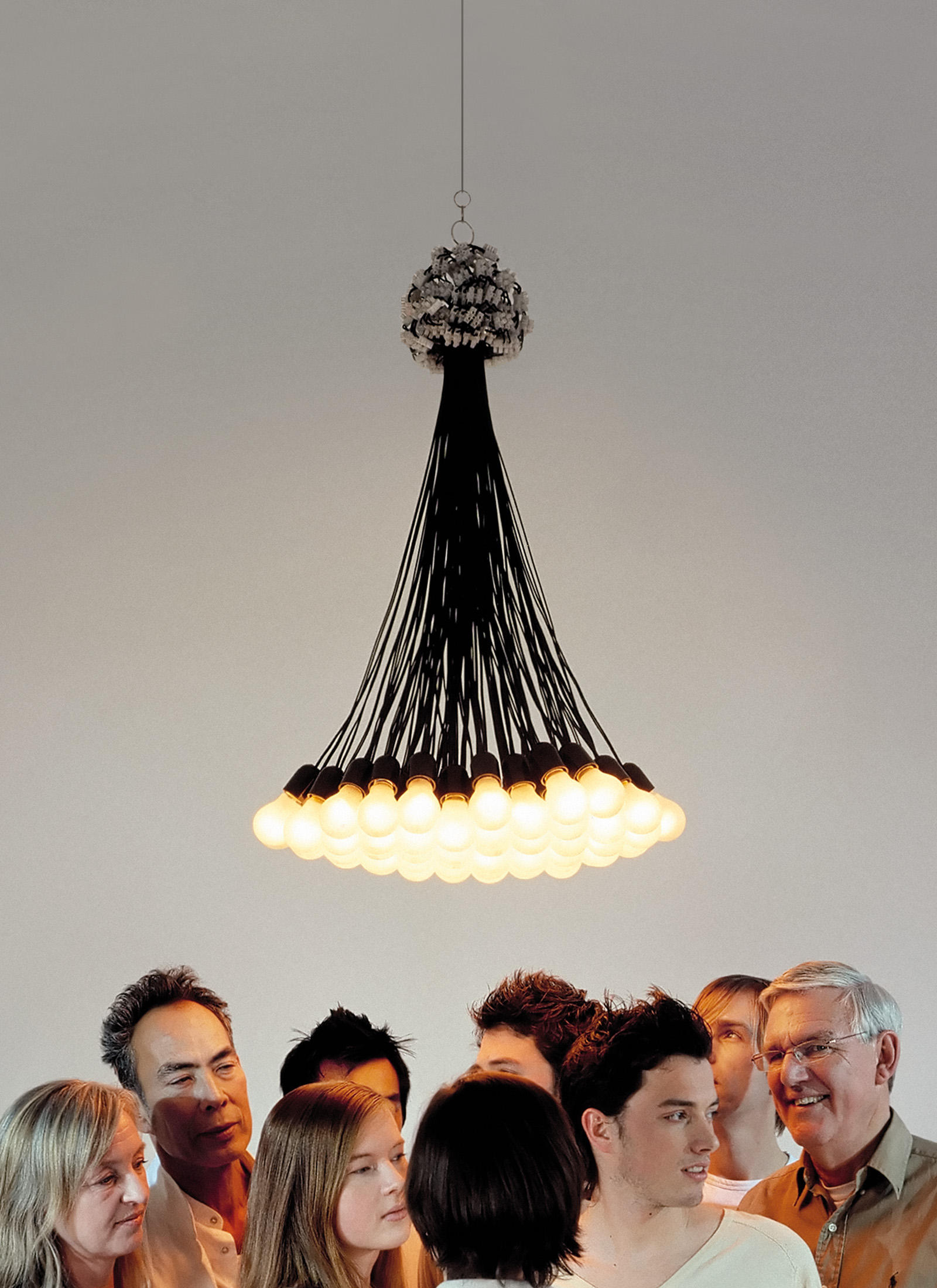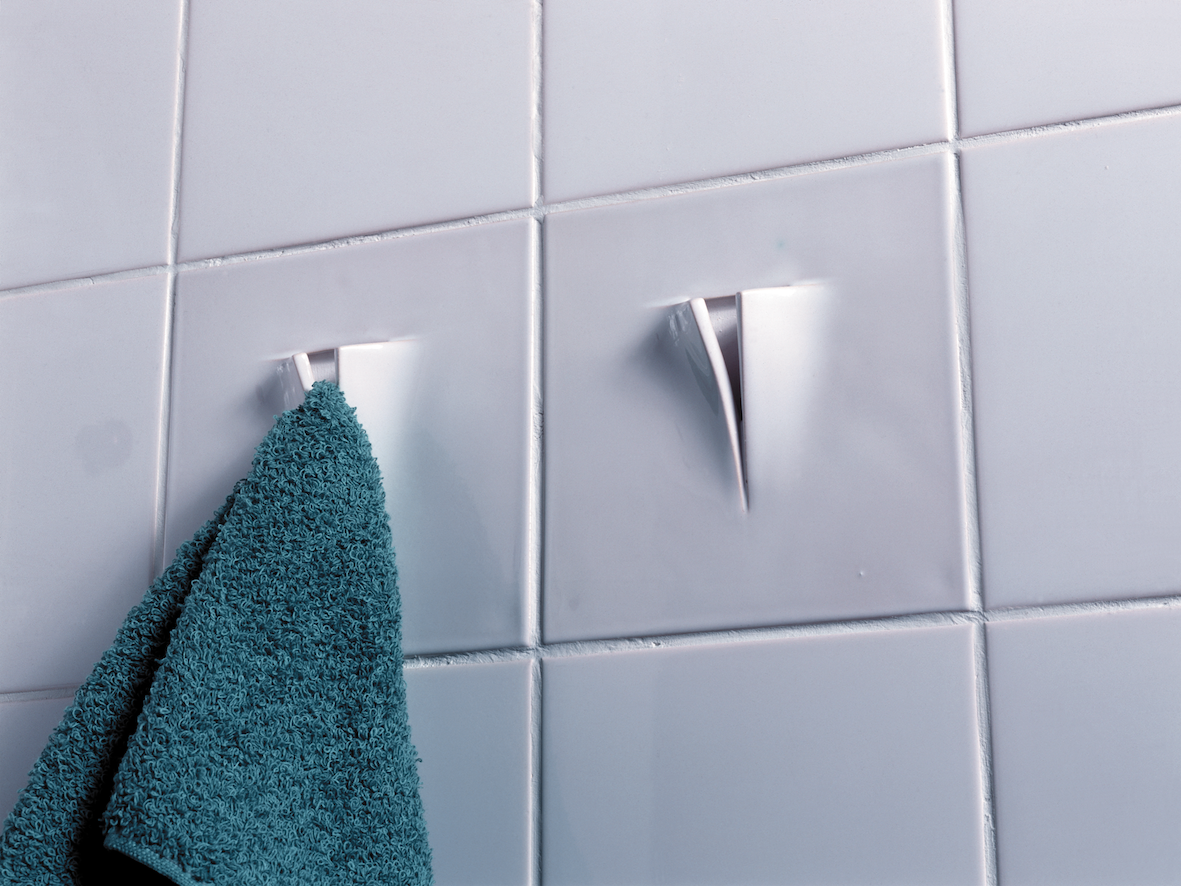Droog is an art collective consisting of a loose group of designers that initially came together in April 1993, when Renny Ramakers and Gijs Bakker presented a collection of products at the Milan Furniture Fair. Named after the Dutch word for “dry”, signifying the dry wit of the collection, Droog has continued to grow into a company with several outlets in Amsterdam. Notable figures include Renny Ramakers, Gijs Bakker, Marcel Wanders, Tejo Remy and Jurgen Bey.
Droog responds to the Dutch condition in which most of the country is artificial land gleaned from rivers and seas (even one third lies below sea level). Because land is so precious, the Dutch value both preservation of existing conditions as well as experimentation that will allow more profitable uses of that reality. Droog reflects and maps this process, producing art that displays its own process and disappears into the recombination of what already exists.
Droog draws its attitude and methodology from Postmodernism. Postmodernism questioned the modern narrative that all progress – especially technological – is positive, especially since it encouraged a culture of consumption. As a critical reaction to the consumerist mindset and wasteful overconsumption, Droog, similarly, is concerned with sustainability. Furthermore, Postmodernist products unite in their ironical and playful treatment of a subject, similar to Droog.
The influence of Minimalism can also be seen on Droog. Minimalism and Droog share similarities in the attention given to the materiality of the works. This materiality manifests in the visceral experience created for the user through the utilization of sensory aspects such as touch and smell.
This viscerality can be observed in Tejo Remy’s Chest of Drawers, comprised of an assortment of found drawers from discarded old furniture, each encased in new timber cases and tied together with a strap. The sustainable approach of Droog can be clearly observed in Remy’s reusing of discarded drawers. However, Remy’s approach to recycling does not merely stop at the re-use of materials – the work also recycles conceptual values, re-using the ideas, memories and archetypes of the drawers to give the work a sense of longevity. Indeed, Remy called the object “You can’t lay down your memories” and spoke of the individual character and memories encapsulated in individual drawers. As we open the drawers, the scent of the old drawers, along with their unique scratches and other marks, are visceral phenomena that awaken our memories. Why this approach of tapping onto our memories? Droog realized that longevity is achieved through emotional or symbolic appeal. Imbuing objects with expressive values so that we want to keep them for longer then becomes a mechanism for short-circuiting rapid obsolescence, which ties in with Droog’s sustainable ideals.
As such, the core belief of Droog is that design was not a question of making more objects, using more materials, or even inventing new ideas or solutions to the problems we encounter in our daily lives, but one of finding more ways to experience, explore and expand the possibilities of existing objects, images, spaces and ideas.
This idea is brought home with Treetrunk Bench. Seasonal winds and unexpected storms give way to thousands of fallen trees across the country each year. Rather than sending those trunks down the wood chipper, Bey fixed bronze chair backs into the trunk to create seating. The original work was part of the “Couleur Locale” installation. Aimed at revitalizing the area around the former estate of a Dutch princess, the presentation consisted of other works such as orange lollipops moulded around orange seeds so that you could plant them to grow new trees, a machine that would spit out a bench-shaped compression of old leaves raked off the ground. Through the mechanism of gathering and re-shaping, they created the ability to enjoy the park’s rebirth in the spring.
The primary source used for this essay is “Simply Droog: 10 + 3 years of creating innovation and discussion”, published by Droog itself. Ten themes were identified: Use-it-again, Familiar-not so familiar, Open design, Inevitable ornament, Simplicity, Irony, Tactility, Endless Contamination (Hybridization), Experience and Form follows process. Use-it-again has been discussed, so we shall move on to the other themes, categorized under separate sub-headings for easier readability.
Familiar-not so familiar
Many of the objects in the Droog design collection play an interesting game with memory. Droog realizes that the role played by everyday use-objects is quite limited – they are mainly meant to be instrumental and reliable. Trivial use-objects can awaken memories, but these functional objects can also tell a story of their own. Droog awakens the narrative power of these objects.
For example, the knitting around the archetypal coffee pot tells a story that the pot itself does not tell because we have seen it so often. We see a world of domestic comfort appearing before our mind’s eye, we see generations sitting at the table. Maybe we even see a coffee pot fallen to pieces and held together by neat knitting. The imagination is challenged.
Open Design
The distinction between closed and open specificity is the degree to which the perception of products are predetermined. In open specificity, the experience that the concept may trigger is not hinted at, even though it is present. The impact of the object does not become clear until it reaches the receiving end. Droog Design prefers the open end, leaving room for the user to customize their own experience. The common denominator across their remarkable projects is Droog’s ability to combine mass production and individual identity.

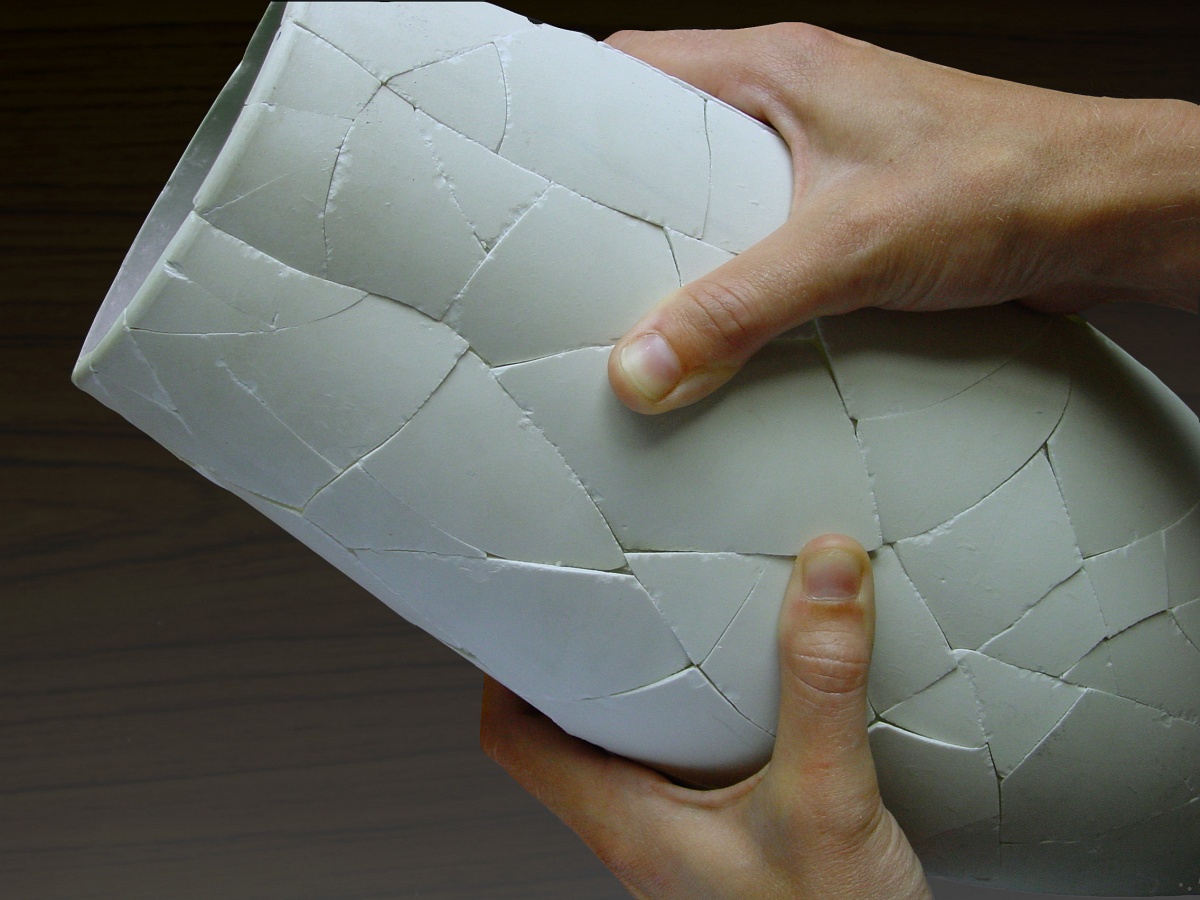 “Do Break”, Frank Tjepkema, Peter van de Jagt, 2000
“Do Break”, Frank Tjepkema, Peter van de Jagt, 2000
For “Do Break”, the porcelain vase is covered inside with a layer of silicone rubber. After you have bought it, you can smash it. The silicone holds the shards in place, and the owner then has a unique vase.
Inevitable ornament
Since the 1920s it was believed that the Bauhaus formula of ‘form follows function’ required a sober, minimalist language of forms. Nor was this austerity completely abandoned when at the end of the 20th century, the slogan for many designers became “form follows concept”. Dutch designers working in a conceptual allowed themselves more liberties such as humor that extended beyond the function, but their visual language was still kept simple as it had to be justified, not by form but concept.
Droog design stresses that conceptual design and ornament are very compatible, as long as the underlying idea gives rise to it. In 85 lamps, the function even merges with ornament. The bundle of ordinary light bulbs and the knot of chandelier connections on top are at the same time technical necessities as well as decorative accents. Also, although it may seem to us that the chandelier is not ecologically friendly – 85 light bulbs would consume a large amount of energy and produce lots of heat – it made sense in the European context as the chandelier was also used as a heater in cold weather.
Simplicity
Droog sought simplicity in using materials in a direct and unidealized way. This can again be seen in 85 lamps, for the chandelier does not magically transform into something more grandiose. The lamps hide nothing, asserting their normalcy without apology.
Tactility
As humans, we always want to reach out and touch things. With Droog, products are no longer just objects that look good but can now be described as ‘soft’ or ‘cold’ ,which creates personality for the objects.

“Bathroom Mat”, Hella Jongerius, 1993. A mat made to look and feel like bubbles so that its soft when the user steps on it, yet creates texture so that slipping is prevented.
Hybridization
Droog is also concerned with the combination of functions, forms or concepts. This saves space, but more importantly, reduces the need for another product, which reduces waste.
For example, these tiles function both as bathroom tiles as well as hangers for towels or other clothes/products.
Experience
Droog engages with the user’s experience, with its products facilitating interaction that makes a product more memorable and creates an emotional connection, again, as a measure against rapid obsolescence.
Here, interaction is encouraged between users as they can sit on rolling plates (on marbles) and slide along the bench to talk to one another.
Form follows process
Droog believes the process of making an object to be just as, if not more, important than the final product. The designer has lesser control, which creates outcomes that are unexpectedly, accidentally beautiful. This can be related to William Morris’ ideology that the designer should enjoy and revel in the beauty of his work.
Droog’s innovative products set new standards within the industry and helped shape contemporary design practices. Today, Droog remains dedicated to forward-thinking design and has branched into socially conscious urban research.
Bibliography
Droog Design(2006) Simply Droog: 10 + 3 Years of Creating Innovation and Discussion, 2nd edn. The Netherlands: Uitgeverij 010 Publishers.
Droog.com (2018) (online) Available at : https://www.droog.com (Accessed: 20 Oct 2018)
Studio International (2017) Simply Artful, Simply Functional, Simply Droog (Online) Available at: https://www.studiointernational.com/index.php/simply-artful–simply-functional–simply-droog (Accessed: 20 Oct 2018)
The New York Times (2018) Is It Design? Art? Or Just a Dutch Joke? (Online) Available at: https://www.nytimes.com/2006/12/30/arts/design/30droo.html (Accessed: 20 Oct 2018)
Urbis magazine(2018) In focus:Marcel Wanders(Online) Available at: https://urbismagazine.com/articles/in-focus-marcel-wanders (Accessed: 20 Oct 2018)
Tjep.com. (2018). Do break. [online] Available at: http://www.tjep.com/projects/works/15-icons/do-break (Accessed 14 Oct. 2018)
Studiomakkinkbey.nl. (2018). Products – Studio Makkink & Bey. (Online) Available at: http://www.studiomakkinkbey.nl/list/products/4014_tree_trunk_bench (Accessed 20 Oct. 2018)


